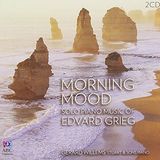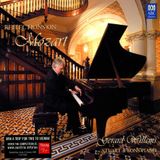“All my life I have felt connected to Beethoven. For me his music is rock-solid. It's really the salt of the earth. When I was only 12. I’d just arrived in Australia and was listening to ABC radio, and all of a sudden I heard the strains of Beethoven’s Moonlight Sonata and I’d never heard anything so beautiful. Time stood still for me and that was probably when I made the decision if I’m going to live life on this earth I’m going to be involved with music.”
Dutch-born Australian pianist Gerard Willems AM, “fell into my career by chance. I just wanted to play the piano, it didn’t matter in what form. And as a result I’ve finished up doing all sorts of wonderful things.”
The “thing” that catapulted Willems into the history books and made him a household name, was his marathon mission to record all of Beethoven’s major piano works: including the 32 piano sonatas, five piano concertos, and Diabelli Variations on the newly Australian designed and manufactured Stuart & Sons piano for the ABC Classics label.
Willems was the first Australian to achieve this feat, becoming the best-selling classical artist in Australian recording history. The project was the largest ever undertaken in Australia, winning successive ARIAS in 1999 and 2000. “The fact I played all the Beethoven sonatas on the Stuart piano gave me an international uniqueness” says Willems. “We all know these works so well, but it was almost like a spring clean.”
Professor Robert Constable, the then dean at the faculty of music at the Newcastle Conservatorium, which in 1995 initiated the Stuart piano research project, describes Willems as “one of the most unflappable musicians but he has the fire in his belly when it really counts. Not many pianists can play all 32 Beethoven sonatas. You have to have a certain combination of skills to record them: the musical insight, and the temperament to be able to maintain this gruelling schedule without burning out.”
Newcastle piano maker Wayne Stuart spent two years developing the instrument, handcrafted from Huon pine. Grander than any previous design, the Stuart piano has 102 notes, 14 notes more than the standard concert grand. Stuart says the traditional piano needed “revitalisation and redirection.” Willems says the extra keys “Give the piano a more dramatic colour, an orchestral sound. Beethoven was often said to say ‘this piano is just too small scale for me. I want something much bigger, more robust.’”
Buy, stream or down Willems's complete Beethoven collection by ABC Classic.
The Beethoven connection
The amiable, modest Willems is an unlikely classical celebrity. He wears his unexpected fame lightly, as listeners to broadcasts of the Sydney International Piano Competition will know. As ABC Classic’s regular expert commentator, Gerard combines his deep love and knowledge of piano repertoire with an infectious sense of humour.
Gerardus Maria Willems was born in 1946 in Tilburg in the Netherlands, a town near the Belgian border. He was named after his maternal grandfather, a church organist, composer and piano builder. Beethoven too had a Belgian grandparent. His paternal grandfather worked in the nearby southern Brabant region as a choirmaster and church musician. Fate determined Willems and Beethoven would meet up in Australia.
As a boy, young Gerard helped his family out working as a debt collector, riding his bike through snowstorms at times for his boss. "I came face to face with some pretty tough nuts," he recalls.” But it probably gave the lad resilience for what lay ahead.
There was plenty of culture in the family home. “I grew up surrounded by music and art and beautiful architecture. I was in a church choir as a boy, but from a very young age I felt that I communicated best through the piano. I had a feeling of destiny about it.”
He remembers his father Jan (a chemist by profession but also a writer and painter) playing Chopin’s funeral march on their Steinbach piano when he was four or five. “I never thought of it as morose, for the same reason as the funeral march of the second movement of Beethoven’s Eroica symphony is not morose. I find (both) intensely beautiful. Things that are beautiful are often to do with pain and anguish. Through pain and anguish many of the greatest works of art have been created.”
“Music was my destiny”
The Soviet invasion of Hungary in 1956 had a huge effect on Europeans recovering from the domination of the Germans during the second world war. Gerard was 12 when “my parents decided to move away as far as possible, and in 1958, we came to Australia.”
The family was placed in the Fairy Meadow Migrant Hostel near Wollongong, south of Sydney. They lived in Nissen huts surrounded by barbed wire in rooms divided by cardboard boxes. “My sister thought it was the greatest adventure, but for me it was traumatic. I was like a transplanted rose that suddenly had to survive in the Sahara desert.”
Gerard says “the contrast with Europe was particularly stark. Wollongong was a pretty redneck, wild town in those days. I tried to assimilate but I didn’t fit in. But music kept me on the path which I had absolutely a feeling of destiny about.”
“My parents made a lot of sacrifices”
Fortuitously, the family piano had moved with them to Australia. “That piano (the Steinbach) was a saving grace. My grandfather had his own piano factory and he gave my mother the piano as a wedding present. Because I didn’t speak much English, I realised that by playing the piano I could communicate with people and gain friends, but I did lead a rather isolated life there in the hut.”
Gerard’s father was determined his son’s musical talents shouldn’t be sacrificed because of their difficult circumstances. “We would don our best clothes and board the bus to Wollongong where we listened spellbound to visiting pianists in recitals such as Brendel, Entremont and Nikolayeva. Later I heard Rubinstein in Sydney. That was very important for me, particularly in the late ‘50s, coming to Australia which was so far removed from these European traditions.” They even met the artists after concerts and had dinner with them. “Sometimes they were relieved to be able to converse in German.”
Gerard himself was entering piano competitions, winning the Wollongong Eisteddfod Piano Championship Cup for three consecutive years. His parents “made a lot of sacrifices to keep us children in school rather than sending us to work at the factory.” His mother supported the family by working in the camp kitchen. But tragedy struck whilst he was still a teenager.
“I’m free now, to do what I want to do”
Unlike his older brother who also learned piano but became an engineer, Gerard ignored his father’s advice to have a fall-back profession and formalised his obsession with piano at the age of 15, starting lessons with a local teacher, Janet Mathews, whose daughter, the late Justice Jane Mathews vividly recalls Gerard’s first lesson. “This big, gangly young fellow came in. I concealed myself in the room next to the one where the piano was and the moment he played to me it was like an angel. My mother took him on immediately and he was the most rewarding and best and most talented student she ever had in her teaching career.”
Gerard’s father Jan, never left the migrant camp. One morning, when he was 17, his mother woke him with the words “Papa has just died.” “The first thing that came through my mind before I started to grieve about the loss of my father, was ‘I’m free now, to do what I want to do.’ It made me grow up very quickly.” Gerard imagined Chopin’s Funeral March at his father’s funeral.
Noting his father’s short life and death from cancer “which I almost feel was because of the stress of losing his position and status in coming to Australia”, Willems made a pledge to make the most of his own. “You have to keep thinking that you are on the path you want to be on, regardless of your detractors.”
The big smoke
Janet Mathews prepared Gerard for his entrance to the Sydney Conservatorium. Winning a Commonwealth Scholarship, he studied with Gordon Watson during the mid-60s. “I made progress so fast that at the end of the first year I’d got to the level of playing a concerto with the Sydney Symphony. Watson was a very cultured man and he took me under his wing almost like a surrogate father.” A line can actually be traced back through Watson’s teacher to Beethoven’s pupil Czerny, making Willems Beethoven’s great- great-great-great Grand-pupil!
Watson predicted a big international career for Willems, who graduated with honours, organizing overseas contacts and study for him as Gerard wanted to return to the Netherlands. But world events intervened once again and Gerard was conscripted to the Vietnam War. His international studies and concert career on hold whilst he played clarinet in the army band for two years, after he managed to convince the authorities he was best suited as a musician.
Once back in civvies, he worked as a touring pianist for the Australian Ballet, travelling on tour with dancers like Margot Fonteyn and Rudolf Nureyev. “It was a big deal,” recalls Willems, who was also on the first tour to the west by Russian stars Mikhail Baryshnikov and Natalia Makarova. “I loved the ballet world.”
Australia beckons, again
In the 1970s Gerard and his wife and young family moved back to Europe where he had further lessons with Claudio Arrau’s assistant, Greville Rothon, in Munich. He made his London debut in 1974 and concerts in Munich and Amsterdam followed in the late ‘70s. Despite regular work in Europe, when an offer came to take up a position at the Sydney Conservatorium, Gerard made the decision to re-emigrate to Australia in 1981. His choice this time and the right one, he says.
He became a successful and esteemed pedagogue as a senior lecturer at the Conservatorium, and later the University of Sydney, at the same time touring extensively for the ABC, performing with all the major orchestras, giving concerts for Musica Viva and appearing at major festivals. He continued to record for a number of record labels in addition to ABC Classics.
In 2001 Gerard was awarded the Queen Elizabeth II prize by the Australian Elizabethan Theatre Trust to research Early Music Performance Practice in Europe and USA.
“This is a dream for a pianist”
Last October, life came full circle when Gerard gave his first recitals decades on from his departure, in his hometown of Tilburg. Two sold-out concerts on the same day. It was a very emotional home-coming and of course Beethoven was on the program.
Looking back on his life Gerard Willems says “the ABC has really made my name through my recordings of Beethoven. Two ARIAS, and sales into the hundreds of thousands which is mind-boggling for the classical area. Forty years ago, I would not have thought all this was possible but now that it’s happened I would never want to turn the clock back. Not many people are given the chance to record all the sonatas. This is a dream for a pianist, to be able to sit down and record for perpetuity. I feel privileged, and every day I thank my father for having the courage and daring to bring us to Australia.”
Mairi Nicolson presents Lunchtime Concert, The Opera Show and Sunday Opera on ABC Classic.


